
A firearm is any type of gun that uses an explosive charge and is designed to be readily carried and used by an individual. The term is legally defined further in different countries.

Flintlock is a general term for any firearm that uses a flint-striking ignition mechanism, the first of which appeared in Western Europe in the early 16th century. The term may also apply to a particular form of the mechanism itself, also known as the true flintlock, that was introduced in the early 17th century, and gradually replaced earlier firearm-ignition technologies, such as the matchlock, the wheellock, and the earlier flintlock mechanisms such as the snaplock and snaphaunce.

An arquebus is a form of long gun that appeared in Europe and the Ottoman Empire during the 15th century. An infantryman armed with an arquebus is called an arquebusier.

A musket is a muzzle-loaded long gun that appeared as a smoothbore weapon in the early 16th century, at first as a heavier variant of the arquebus, capable of penetrating plate armour. By the mid-16th century, this type of musket gradually disappeared as the use of heavy armour declined, but musket continued as the generic term for smoothbore long guns until the mid-19th century. In turn, this style of musket was retired in the 19th century when rifled muskets using the Minié ball became common. The development of breech-loading firearms using self-contained cartridges and the first reliable repeating rifles produced by Winchester Repeating Arms Company in 1860 also led to their demise. By the time that repeating rifles became common, they were known as simply "rifles", ending the era of the musket.

A wheellock, wheel-lock, or wheel lock is a friction-wheel mechanism which creates a spark that causes a firearm to fire. It was the next major development in firearms technology after the matchlock and the first self-igniting firearm. Its name is from its rotating steel wheel to provide ignition. Developed in Europe around 1500, it was used alongside the matchlock, the snaplock, the snaphance, and the flintlock.

A matchlock or firelock is a historical type of firearm wherein the gunpowder is ignited by a burning piece of flammable cord or twine that is touched to the gunpowder by a mechanism that the musketeer activates by pulling a lever or trigger with their finger. This firing mechanism was an improvement over the hand cannon, which lacked a trigger and required the musketeer or an assistant to apply a match directly to the gunpowder by hand. The matchlock mechanism allowed the musketeer to apply the match himself without losing his concentration.

A snaphance or snaphaunce is a type of firearm lock in which a flint struck against a striker plate above a steel pan ignites the priming powder which fires the gun. It is the mechanical progression of the wheellock firing mechanism, and along with the miquelet lock and doglock are predecessors of the flintlock mechanism.

The flintlock mechanism is a type of lock used on muskets, rifles, and pistols from the early 17th to the mid-19th century. It is commonly referred to as a "flintlock". The term is also used for the weapons themselves as a whole, and not just the lock mechanism.

Slow match, also called match cord, is the slow-burning cord or twine fuse used by early gunpowder musketeers, artillerymen, and soldiers to ignite matchlock muskets, cannons, shells, and petards. Slow matches were most suitable for use around black-powder weapons because a slow match could be roughly handled without going out, and only presented a small glowing tip instead of a large flame that risked igniting nearby gunpowder. Slow match of various types was one of the first kinds of artillery fuse.

The lock of a firearm is the mechanism used to initiate firing. It is a historical term, in that it generally refers to such mechanisms used in muzzle-loading and early breech-loading firearms. Side-lock refers to the type of construction, in which the individual components of the mechanism are mounted either side of a single plate. The assembly is then mounted to the stock on the side of the firearm. In modern firearm designs, the mechanism to initiate firing is generally constructed within the frame or receiver of the firearm and is referred to as the firing or trigger mechanism.

A snaplock is a type of lock for firing a gun or is a gun fired by such a lock.

A handgun is a firearm designed to be usable with only one hand. It is distinguished from a long gun which needs to be held by both hands and braced against the shoulder. Handguns have shorter effective ranges compared to long guns, and are much harder to shoot accurately. While most early handguns are single-shot pistols, the two most common types of handguns used in modern times are revolvers and semi-automatic pistols, although other handguns such as derringers and machine pistols also see infrequent usage.
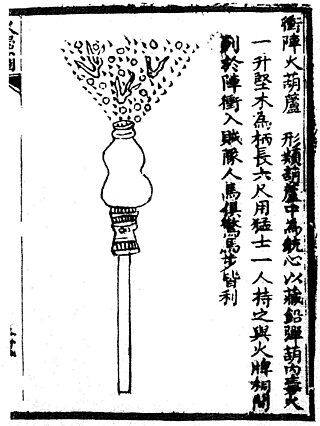
The history of firearms begins in 10th-century China, when tubes containing gunpowder and pellet projectiles were mounted on spears to make portable fire lances, operable by one person. This was later used effectively as a shock weapon in the Siege of De'an in 1132. In the 13th century, fire lance barrels were replaced with metal tubes and transformed into metal-barreled hand cannons. The technology gradually spread throughout Eurasia during the 14th century and evolved into flintlocks, blunderbusses, and other variants. The 19th and 20th centuries saw an acceleration in this evolution, with the introduction of the magazine, belt-fed weapons, metal cartridges, and the automatic firearm. Older firearms typically used black powder as a propellant, but modern firearms use smokeless powder or other propellants. Most modern firearms have rifled barrels.
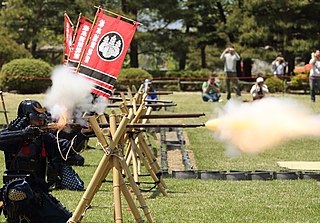
Hōjutsu (砲術), the art of gunnery, is the martial art of Japan dedicated to Japanese black powder firearm usage.
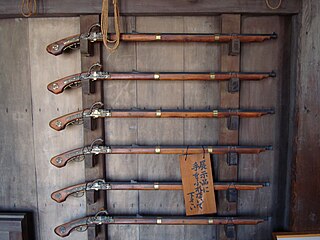
Firearms were introduced to Japan in the 13th century during the first Mongol invasion, referred to as teppō. Portuguese firearms were introduced in 1543, and intense development followed, with strong local manufacture during the period of conflicts of the late 16th century. Hōjutsu, the art of gunnery, is the Japanese martial art dedicated to firearms usage.
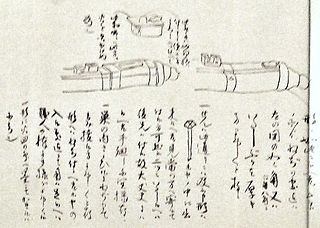
Artillery in Japan was first used during the Sengoku period in the 16th century; and its use has continued to develop.
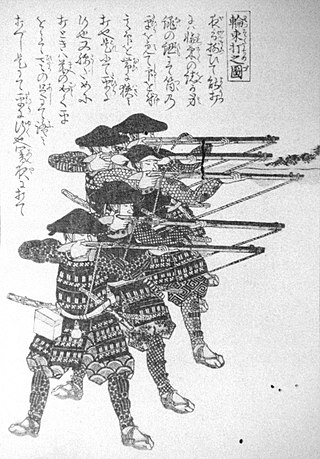
Tanegashima, most often called in Japanese and sometimes in English hinawajū, was a type of matchlock-configured arquebus firearm introduced to Japan through the Portuguese Empire in 1543. It was used by the samurai class and their ashigaru "foot soldiers", and within a few years its introduction in battle changed the way war was fought in Japan forever. It, however, could not completely replace the yumi (longbow). Although the Japanese developed various techniques to improve the gun's shortcomings, specifically its slow rate of fire and inability to fire in the rain, it remained inferior to the yumi in these respects, and the latter continued to be an important weapon on the battlefield. After Tokugawa Ieyasu destroyed the Toyotomi clan in the siege of Osaka and established the Tokugawa shogunate, the relatively peaceful Edo period arrived, and the use of tanegashima declined.

Bo hiya is the Japanese version of the fire arrow. Bo-hiya were used in ancient Japan and by the samurai class of feudal Japan.
In firearms and artillery, the primer is the chemical and/or device responsible for initiating the propellant combustion that will propel the projectiles out of the gun barrel.

Istinggar is a type of matchlock firearm built by the various ethnic groups of the Maritime Southeast Asia. The firearm is a result of Portuguese influence on local weaponry after the capture of Malacca (1511). Before this type of gun, in the archipelago already existed early long gun called bedil, or Java arquebus as the Chinese call it. Most of the specimens in the Malay Peninsula are actually Indonesian in origin, manufactured in the Minangkabau lands of West Sumatra. The states of the Malay Peninsula imported this firearm as it was widely used in their wars.


















